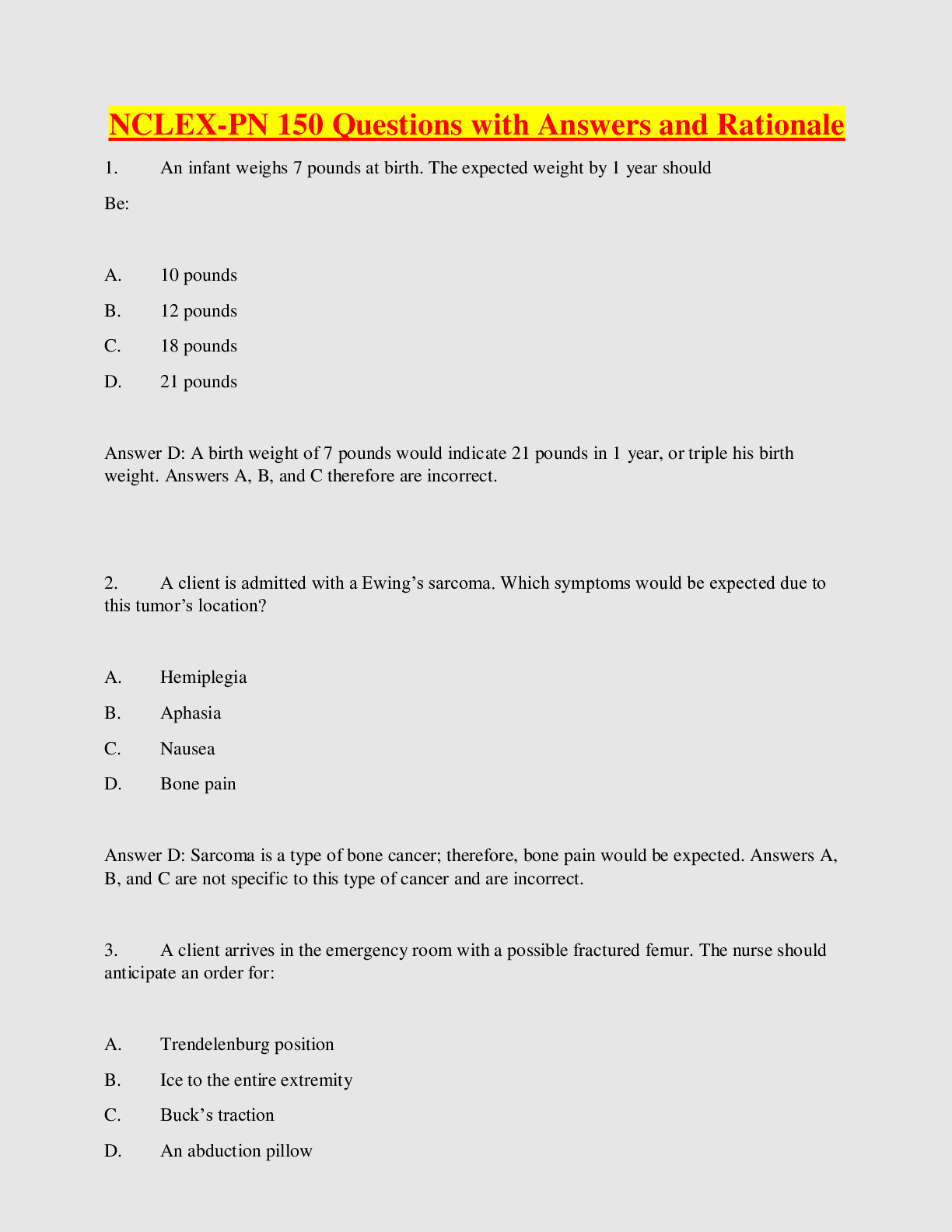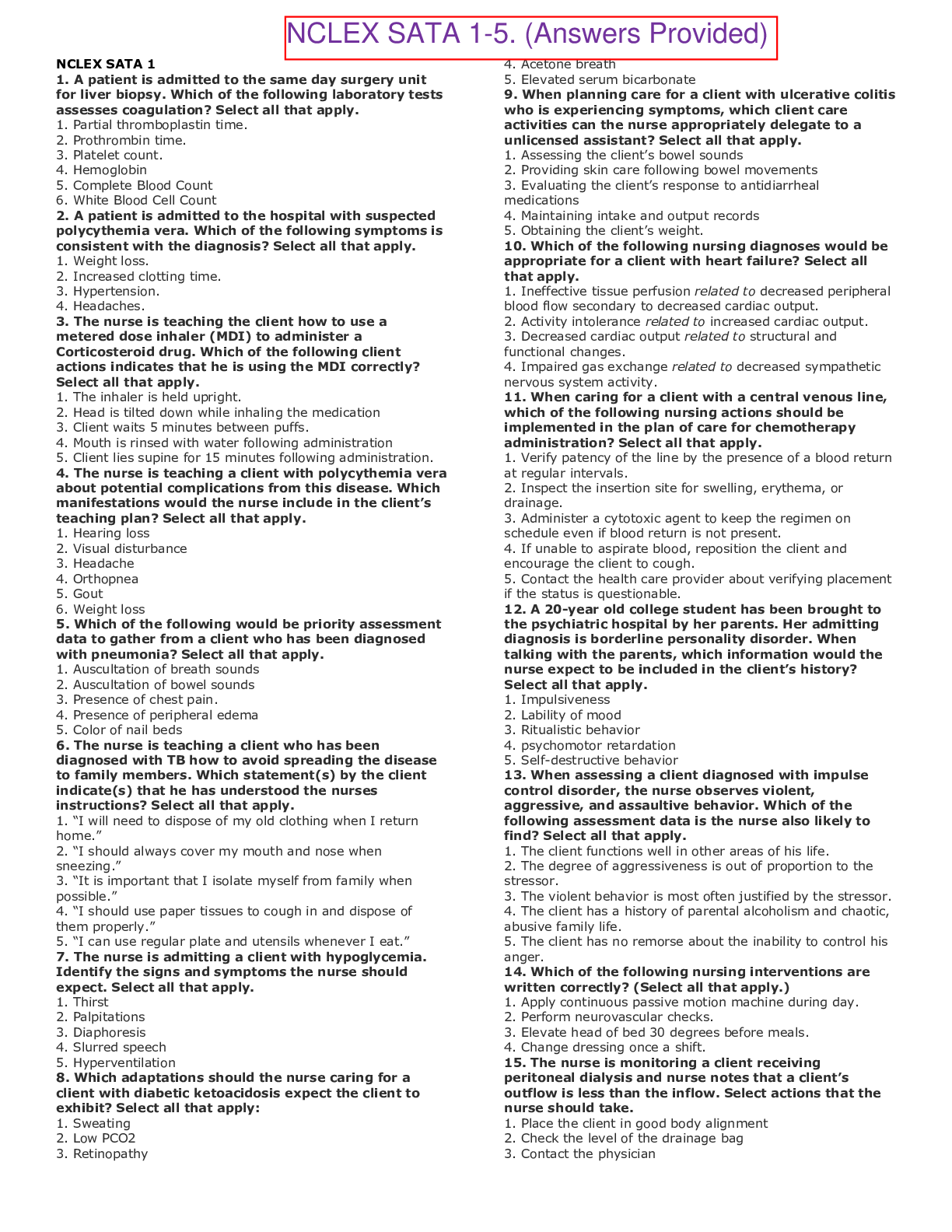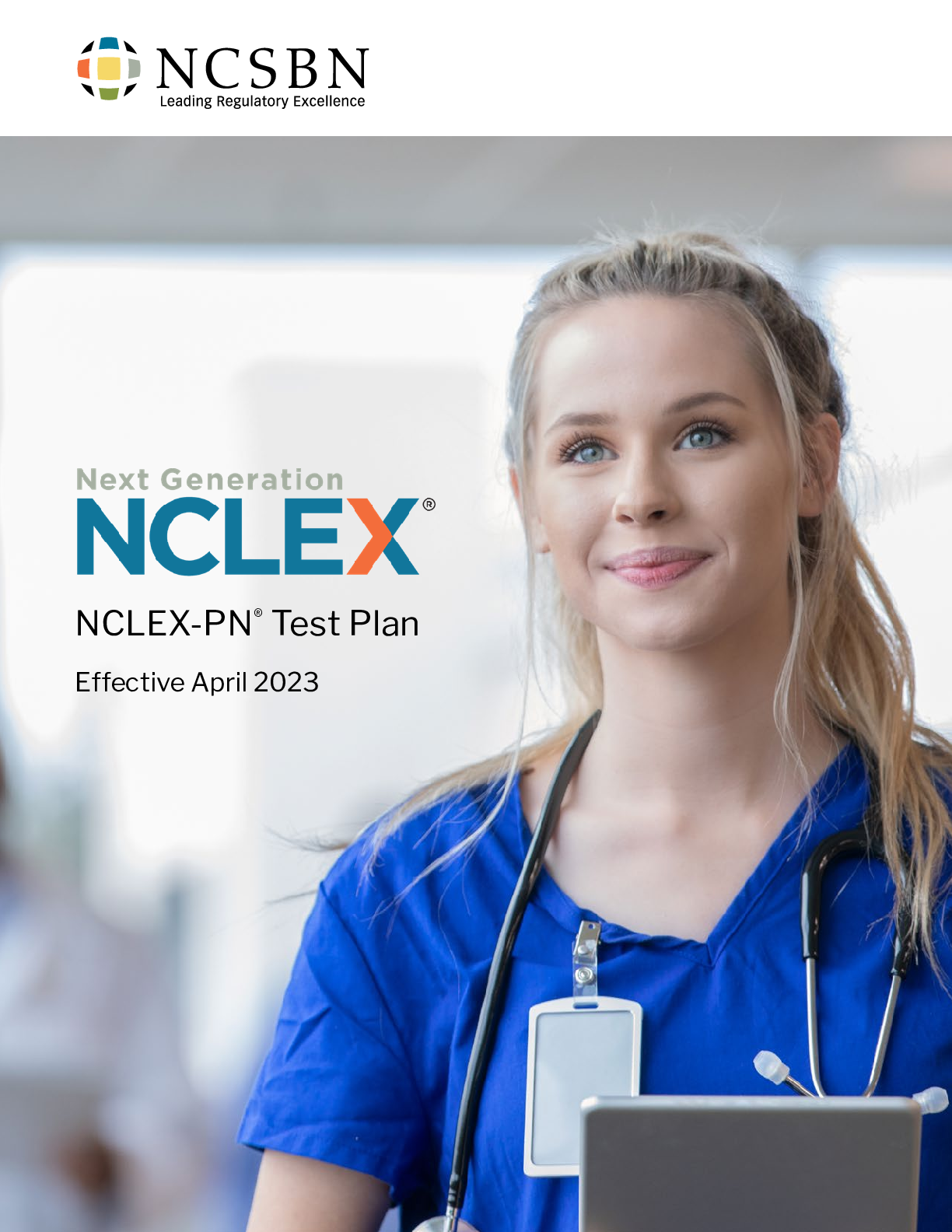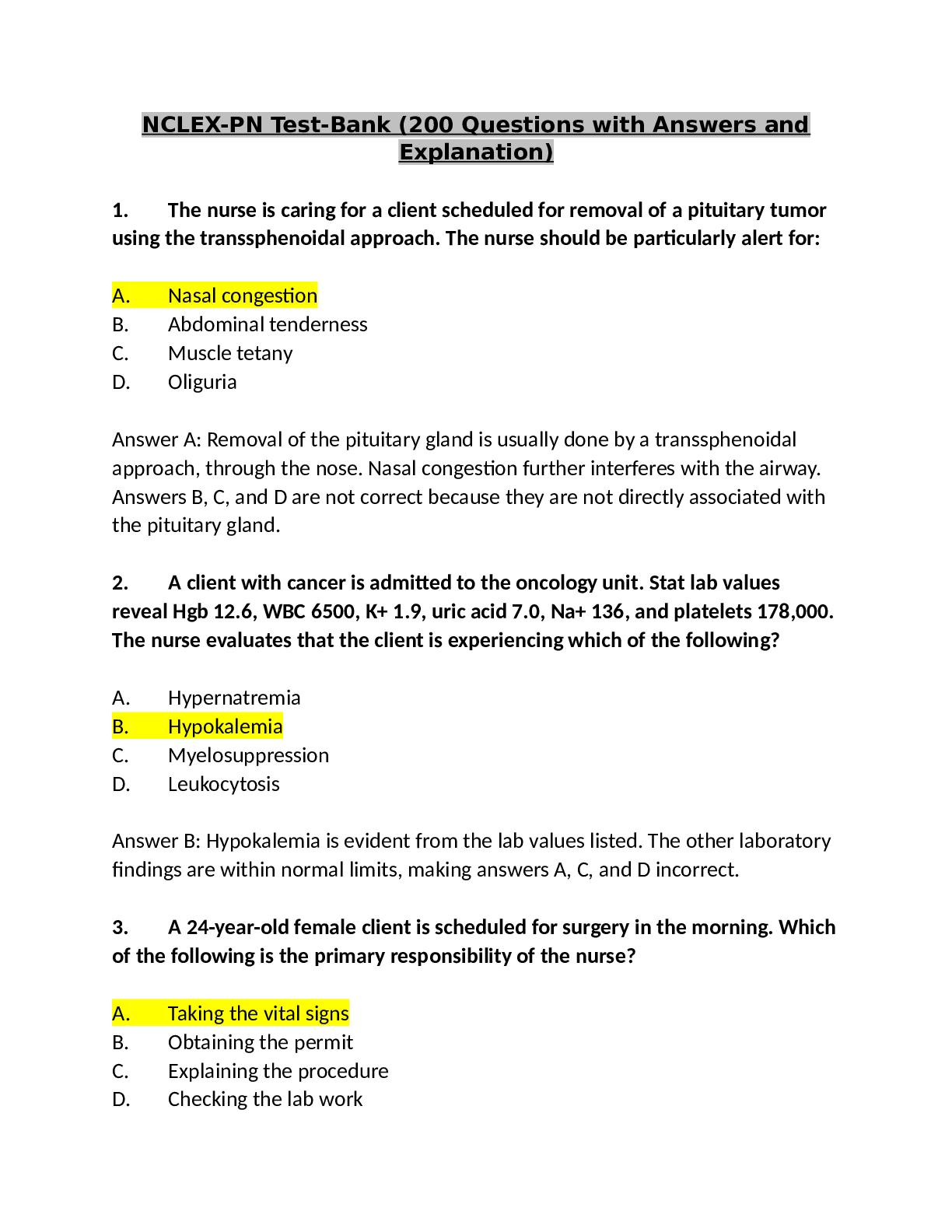Medical Studies > NCLEX-PN > NCLEX QUESTION TRAINER EXPLANATIONS TEST 3 | Med Surg 2210 NCLEX TEST 3 WITH EXPLANATIONS (All)
NCLEX QUESTION TRAINER EXPLANATIONS TEST 3 | Med Surg 2210 NCLEX TEST 3 WITH EXPLANATIONS
Document Content and Description Below
NCLEX QUESTION TRAINER EXPLANATIONS 100 + Questions and answers with explanation TEST 3 1. A client has a total laryngectomy with a permanent tracheostomy. The nurse is planning nutritional intake... for the next three days. Which of the following would be necessary for the nurse to consider regarding the client’s nutrition? 1. To facilitate healing of the surgical area, a nasogastric tube may be utilized and tube feedings may be implemented. 2. The client will be unable to maintain any PO intake as long as he has a tracheotomy in place. 3. Nutritional and/or gastric feedings will not be attempted for approximately three weeks to decrease the incidence of aspiration. 4. Since the client is dependent on the ventilator, nutritional intake will be delayed. Strategy: Think about each answer choice. (1) correct–tube feedings frequently started as the initial nutritional intake; prevents trauma to suture area (2) although the client has permanent tracheotomy, will be able to eat normally after area has healed (3) nutritional intake will begin when bowel sounds return and client can tolerate intake (4) client is not dependent on ventilator 2. The nurse is caring for a client who presents with confusion, mood lability, impaired communication, and lethargy. The nurse should question which of the following orders? 1. Dexamethasone suppression test. 2. Thyroid studies. 3. Drug toxicology screen. 4. Trendelenburg test. Strategy: Think about each test. (1) may be ordered to determine the presence of major depression (2) may be ordered to check for an endocrine cause for the symptoms before the diagnosis of dementia is made (3) may be ordered to see if the client’s symptoms are caused by excessive use of medications or alcohol (4) correct–test is used with a client who may have varicose veins, no relationship to the symptoms described in this situationP R E P A R A T I O N F O R T H E N U R S I N G L I C E N S U R E E X A M I N A T I O N ................................................ 18 ............................................................................................................................................................................................................................................................................ Nursing 3. For a client with a neurological disorder, which of the following nursing assessments will be MOST helpful in determining subtle changes in the client’s level of consciousness? 1. Client posturing. 2. Glasgow coma scale. 3. Client thinking pattern. 4. Occurrence of hallucinations. Strategy: Think about each answer choice. (1) indicates increased intracranial pressure (2) correct–Glasgow coma scale score best evaluates changes in a client’s level of consciousness by evaluating eye-opening, motor, and verbal responses (3) more appropriate for the psychiatric client (4) more appropriate for the psychiatric client 4. The nurse is conducting a physical examination of a client suspected to have bulimia. Which of the following observations by the nurse would MOST likely indicate bulimia? 1. The client has edema of the lower extremities. 2. Physical exam of the client reveals the presence of lanugo. 3. The client has ulcerated mucous membranes of the mouth. 4. The client has dry, yellowish color of the skin. Strategy: Determine the cause of each symptom. Does it relate to bulimia? (1) common with anorexia (2) seen with anorexia (3) correct–due to frequent vomiting (4) bulimics are normal in appearance 5. The nurse is preparing to begin a dopamine (Intropin) infusion on a client. Before beginning the infusion the nurse should 1. evaluate the urine output. 2. obtain the client’s weight. 3. determine the patency of the IV line. 4. measure pulmonary artery pressures. Strategy: Determine how each answer choice relates to dopamine. (1) not a critical assessment at this time (2) contains correct information, but is not a priority (3) correct–if extravasation occurs, there is sloughing of the surrounding skin and tissue; patent IV line is essential to prevent serious side effects (4) not a critical assessment at this time............................................................................................................................ N C L E X Q U E S T I O N T R A I N E R Nursing ........................................................................................................................................................................................................................................................................... 19 6. The nurse is assisting a nursing assistant provide a bed bath to a comatose patient who is incontinent. The nurse should intervene if which of the following actions is noted? 1. The nurse assistant answers the phone while wearing gloves. 2. The nursing assistant log rolls the patient to provide back care. 3. The nursing assistant places an incontinence pad under the patient. 4. The nursing assistant positions the patient on the left side, head elevated. Strategy: “Nurse should intervene” indicates that you are looking for an incorrect action. (1) correct–contaminated gloves should be removed before answering the phone (2) correct way to roll a patient to maintain proper alignment (3) appropriate to use incontinence pad for this patient (4) appropriate position to prevent aspiration and protect the airway 7. A client is going to be taking imipramine (Tofranil) at home following discharge. The nurse should instruct the client to report which of the following immediately to the nurse? 1. Sore throat, fever, increased fatigue, vomiting, diarrhea. 2. Dry mouth, nasal stuffiness, weight gain. 3. Rapid heartbeat, frequent headaches, yellowing of eyes or skin. 4. Weakness, staggering gait, tremor, feeling of drunkenness. Strategy: Think about each answer choice. (1) correct–possible side effects of Tofranil, a tricyclic antidepressant medication, which can be resolved by altering the dosage or changing the medication (2) describes side effects of antidepressants, which client can learn to manage at home without changing the medication (3) describes side effects of a different category of medications (4) describes side effects of a different category of medications 8. The nurse has just received report from the previous shift. Which of the following patients should the nurse see FIRST? 1. A patient who had coronary artery bypass graft (CABG) and will have the atrioventricular (AV) wires removed later in the day. 2. A patient with type I diabetes who is scheduled for a cardiac catheterization later today. 3. A patient who is one-day postoperative and has an epidural catheter in place. 4. A cardiac patient who is being evaluated for a heart transplant. Strategy: Determine which patient is the least stable. (1) although the patient requires a high level of nursing care, no indication that the patient is unstable (2) patient requires preoperative assessment and teaching, no indication that the patient is unstable (3) correct–epidural used for pain relief, monitor for urinary incontinence, hypotension, respiratory depression, and nausea and vomiting (4) requires monitoring but patient with epidural takes priorityP R E P A R A T I O N F O R T H E N U R S I N G L I C E N S U R E E X A M I N A T I O N ................................................ 20 ............................................................................................................................................................................................................................................................................ Nursing 9. An 8-year-old girl has a closed transverse fracture of her right ulna. Which of the following actions, if performed by the nurse before the application of a cast, is MOST important? 1. Check the radial pulses bilaterally and compare. 2. Evaluate the skin temperature and tissue turgor in the area. 3. Assess sensation of each foot while the girl closes her eyes. 4. Apply baby powder to decrease skin irritation under the cast. Strategy: Answers are a mix of assessments and implementations. Does this situation require assessment? Yes. (1) correct–assess neurovascular status, check pain, pallor, paralysis, paresthesia, pulselessness (2) assessment, temperature indicates decreased circulation, but is subjective and not most important (3) assessment, upper (not lower) extremity fracture (4) implementation, should not be done because it would increase skin irritation 10. The nurse is caring for a multipara client who delivered a female infant one hour ago. The nurse observes that the client’s breasts are soft; the uterus is boggy, to the right of the midline, and 2 cm below the umbilicus; moderate lochia rubra. It is MOST important for the nurse to take which of the following actions? 1. Perform a straight catheterization. 2. Offer the client the bedpan. 3. Put the baby to breast. 4. Massage the uterine fundus. Strategy: All answers are implementations. Determine the outcome of each answer choice. Is it desired? (1) encourage the client to void before catheterizing (2) correct–boggy uterus deviated to right indicates full bladder, encourage client to void (3) will increase uterine tone, but the problem is a full bladder (4) findings indicate a full bladder 11. The nurse checks for placement of a nasogastric (NG) tube before beginning a tube feeding for a client. Which of the following results would indicate to the nurse that the tube feeding can begin? 1. A small amount of white mucus is aspirated from the NG tube. 2. The pH of the contents removed from the NG tube is 3. 3. No bubbles are seen when the nurse inverts the NG tube in water. 4. The client says he can feel the NG tube in the back of his throat. Strategy: Determine how the answers relate to a tube feeding. (1) mucus may be from lungs (2) correct–stomach contents are acidic (3) not a safe way to check placement (4) not a reliable indication - - - - - - - - - - - - - - - - - - - - - - - - - - - - - - - - - - - - 88. The nurse is caring for a client who is receiving a tube feeding around the clock. Which of the following nursing actions is MOST appropriate? 1. Rinse the bag and change the formula every four hours. 2. Rinse the bag and change the formula every shift. 3. Change the bag and formula every shift. 4. Rinse the bag and change the formula every two hours. Strategy: All answers are implementations. Determine the outcome of each answer choice. Is it desired? (1) correct–there is an increased growth of organisms after four hours (2) inappropriate due to increased organism growth (3) inappropriate due to increased organism growth (4) not a necessary action to maintain asepsis 89. A 25-year-old primigravida with type I diabetes mellitus is reviewing her insulin regimen with the nurse. The nurse explains to the client that her insulin needs will 1. increase during pregnancy and decrease after delivery. 2. decrease during pregnancy and increase after delivery. 3. increase during pregnancy and remain increased after delivery. 4. decrease during pregnancy and fluctuate after delivery. Strategy: Think about each answer choice. (1) correct–needs increase during pregnancy due to hormonal interference in glucose metabolism (2) needs increase during pregnancy due to hormonal interference in glucose metabolism (3) insulin needs will decrease after delivery (4) needs increase during pregnancy............................................................................................................................ N C L E X Q U E S T I O N T R A I N E R Nursing ........................................................................................................................................................................................................................................................................... 47 90. A client asks what the difference is between his gastric ulcer and his friend’s duodenal ulcer. The nurse’s response should be based on which of the following statements? 1. “Gastric ulcers have an increased association with clients who experience increased psychological pressures.” 2. “The pain of a duodenal ulcer usually occurs two to four hours after meals.” 3. “Clients with gastric ulcers often gain weight, as food alleviates the pain.” 4. “Antacids such as Maalox are seldom prescribed for clients with duodenal ulcers. “ Strategy: Think about each answer choice. (1) refers to duodenal ulcers (2) correct–clients with duodenal ulcers experience pain after meals, e.g., midmorning and midafternoon (3) gastric ulcer clients may be malnourished because food may cause nausea or vomiting (4) antacids are given to duodenal ulcer clients 91. An eight-year-old has been receiving chemotherapy for six months. During her nursing care she asks: “Am I going to die?” Which of the following responses by the nurse is BEST? 1. “Are you afraid of dying?” 2. “Why do you ask that question?” 3. “Only God knows that answer.” 4. “We won’t leave you alone.” Strategy: Remember therapeutic communication. (1) correct–encourages ventilation of thoughts and feelings regarding the concern (2) inappropriate (3) ignores the child’s concern with dying (4) ignores the child’s concern with dying 92. An 11-year-old boy fell off his bicycle and sustains a minor head injury, which is treated at the outpatient clinic. The nurse instructs the boy’s mother about his care at home. The nurse determines that further teaching is necessary if the mother makes which of the following statements? 1. “My son may have dizziness for 24 hours.” 2. “My son can drink carbonated beverages if he vomits.” 3. “My son may complain of nausea.” 4. “My son will probably have a headache.” Strategy: Determine how each answer choice relates to a minor head injury. (1) expected for at least 24 hours (2) correct–unexpected, should be reported to physician immediately, also unexpected is blurred vision, drainage from ear or nose, weakness, slurred speech, worsening headache (3) expected for at least 24 hours (4) expected for at least 24 hours, should not get more intenseP R E P A R A T I O N F O R T H E N U R S I N G L I C E N S U R E E X A M I N A T I O N ................................................ 48 ............................................................................................................................................................................................................................................................................ Nursing 93. The nurse is caring for patients on the psychiatric unit. An extremely angry patient with bipolar illness tells the nurse he just learned his wife has filed for divorce, and he needs to use the phone. Which of the following responses by the nurse is MOST appropriate? 1. Allow the patient to use the phone. 2. Confront the patient about his anger and inappropriate plan of action. 3. Do not allow the patient to use the phone because he is an involuntary patient. 4. Set limits on the patient’s phone use because he has been unable to control his behavior. Strategy: All answers are implementations. Determine the outcome of each answer choice. Is it desired? (1) correct–patient is able to use phone unless otherwise indicated by court order or physician’s order (2) has not lost civil right to use phone (3) denies patient his civil rights (4) inappropriate 94. The nurse is caring for a child in Bryant’s traction. During the neurovascular assessment, the nurse notes that the foot of the uninjured leg feels warmer to touch than that of the broken leg. The nurse should 1. record the observation. 2. encourage the child to move the foot. 3. cover the colder foot with a sock. 4. notify the physician. Strategy: All answers are implementations. Determine the outcome of each answer choice. Is it desired? (1) ignores possibility that Ace bandage is too tight (2) does not relieve the circulation problem (3) does not relieve the circulation problem (4) correct–assessment indicates that Ace bandage is too tight and needs readjusting 95. A 4 lb 10 oz baby boy is delivered at 32 weeks gestation. The infant is admitted to the neonatal intensive care unit and placed in an incubator. He has mottling of the skin and acrocyanosis with irregular respirations of 60. The nurse should recognize these findings as signs of 1. hypoglycemia. 2. cold stress. 3. birth asphyxia. 4. hypovolemia. Strategy: Think about each answer choice. (1) blood sugar less than 25 mg/dL, would see cyanosis, apnea, tachypnea, irregular respirations, diaphoresis, jitteriness, weak cry, lethargy, convulsions, coma (2) correct–symptoms describe cold stress (3) would see meconium stained amniotic fluid (4) would see symptoms of shock............................................................................................................................ N C L E X Q U E S T I O N T R A I N E R Nursing ........................................................................................................................................................................................................................................................................... 49 96. A client was admitted for regulation of her insulin dosage. The client takes 15 units of Humulin N insulin at 8 AM every day. At 4 PM, which of the following nursing observations would indicate a complication from the insulin? 1. Acetone odor to the breath, polyuria, and flushed skin. 2. Irritability, tachycardia, and diaphoresis. 3. Headache, nervousness, and polydipsia. 4. Tenseness, tachycardia, and anorexia. Strategy: Determine the cause of each symptom and how it relates to hypoglycemia. (1) signs of hyperglycemia (2) correct–Humulin N insulin is an intermediate-acting insulin that peaks from eight to twelve hours after administration; this is when signs and symptoms of hypoglycemia will occur (3) signs of hyperglycemia (4) signs of hyperglycemia 97. The nurse is working with a client who has just indicated a wish to kill herself. The client then asks the nurse not to tell anyone. The nurse’s BEST response should be to 1. encourage the client not to do anything without thinking it through very carefully. 2. explain to the client that anything she tells the nurse is kept strictly confidential. 3. report this to staff members in order to protect the client. 4. encourage the client to tell the nurse more about what she is feeling. Strategy: All answers are implementations. Determine the outcome of each answer choice. Is it desired? (1) does not answer client’s immediate concern or give client accurate information about what the nurse will do (2) does not answer client’s immediate concern or give client accurate information about what the nurse will do (3) correct–nurse must let the client know that this information will be shared with the staff so that the client’s safety can be preserved (4) does not answer client’s immediate concern or give client accurate information about what the nurse will do 98. An older woman is hospitalized with a fractured left hip. While awaiting surgery, she is placed in Buck’s traction with a seven-pound weight. Which of the following instructions for moving should be discussed by the nurse to encourage the patient to participate in her care? 1. “Pull up on the overhead trapeze while you push down on your right foot to lift your body.” 2. “With your right arm, grasp the bedside rail on the opposite side and pull yourself over gently.” 3. “I’ll raise the head of the bed 45°, and then you lean forward and rotate your hips to the left.” 4. “Swing your right leg over your left leg, and turn from your waist down, keeping your legs straight.” Strategy: All answers are implementations. Determine the outcome of each answer choice. Is it desired? (1) correct–body must move as single, straight unit (2) turning or twisting from the waist down interferes with countertraction (3) prevents proper pull of weights (4) can’t turn from side to side, can only move up and downP R E P A R A T I O N F O R T H E N U R S I N G L I C E N S U R E E X A M I N A T I O N ................................................ 50 ............................................................................................................................................................................................................................................................................ Nursing 99. The nurse in the pediatrician’s office observes a child in the waiting room. The nurse notes the child can walk up and down steps, has a steady gait, can stand on one foot momentarily, and jumps with both feet. The nurse identifies the child’s chronological age to be 1. 1 year old. 2. 2 years old. 3. 3 years old. 4. 5 years old. Strategy: Picture the child at each age. (1) unable to walk up and down stairs with hand held until 18 months (2) unable to jump until 30 months (3) correct–able to jump with both feet and stand on one foot momentarily at 30 months (4) behaviors are seen in younger child 100. The nurse responds to a train derailment. After making an initial assessment, which of the following clients should the nurse see FIRST? 1. A pregnant woman who states that her clothing is wet. 2. A young man with blood pulsating from a cut on the right leg. 3. A preschool child who is screaming and crying uncontrollably. 4. An unconscious woman with the right leg shorter than the left leg. Strategy: Think ABCs. (1) requires further assessment, could be amniotic fluid or it could be urine. (2) correct–indicates arterial bleeding; apply direct pressure; high risk for shock (3) stable patient (4) possible hip fracture, no indication of respiratory difficulty stated [Show More]
Last updated: 1 year ago
Preview 1 out of 34 pages
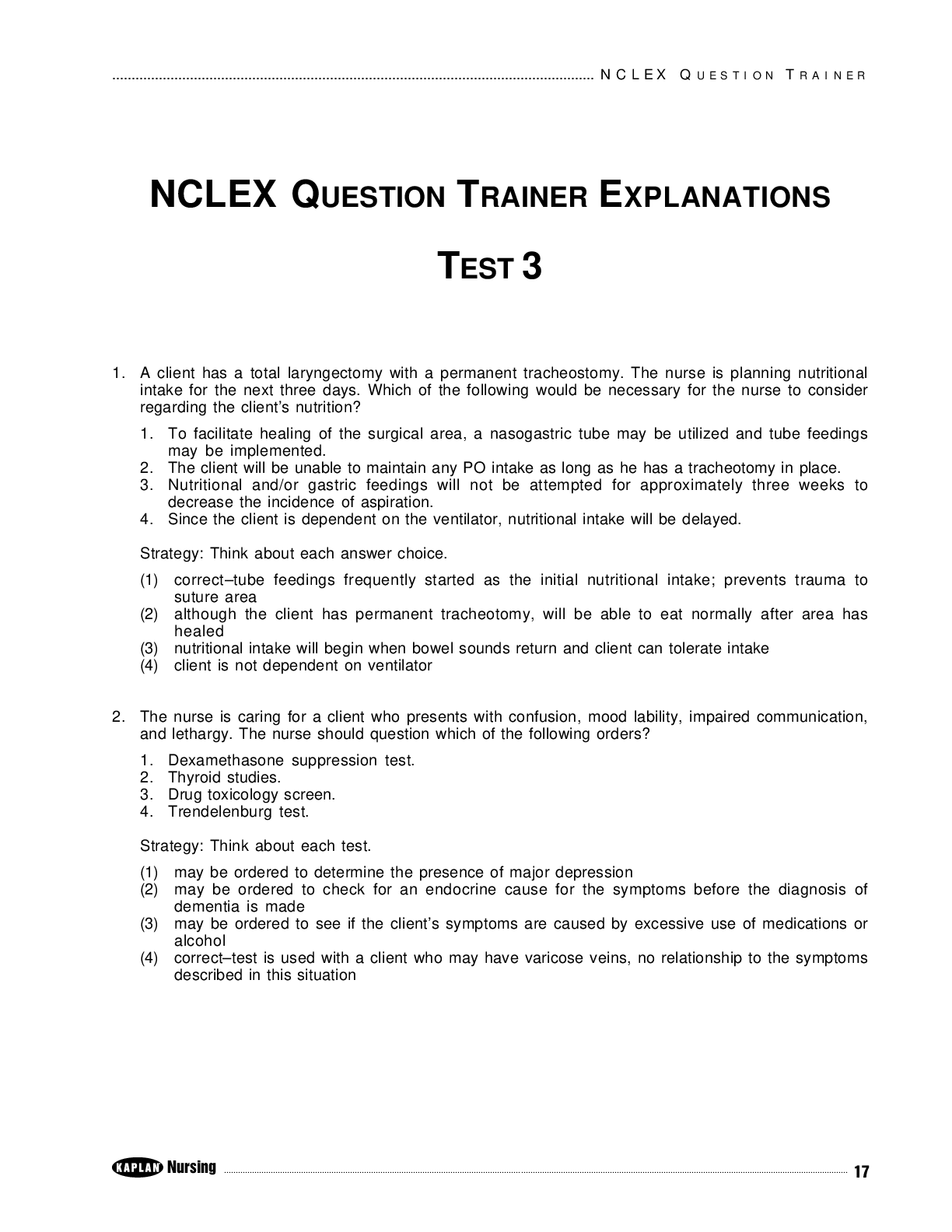
Reviews( 0 )
Document information
Connected school, study & course
About the document
Uploaded On
Aug 04, 2020
Number of pages
34
Written in
Additional information
This document has been written for:
Uploaded
Aug 04, 2020
Downloads
0
Views
124

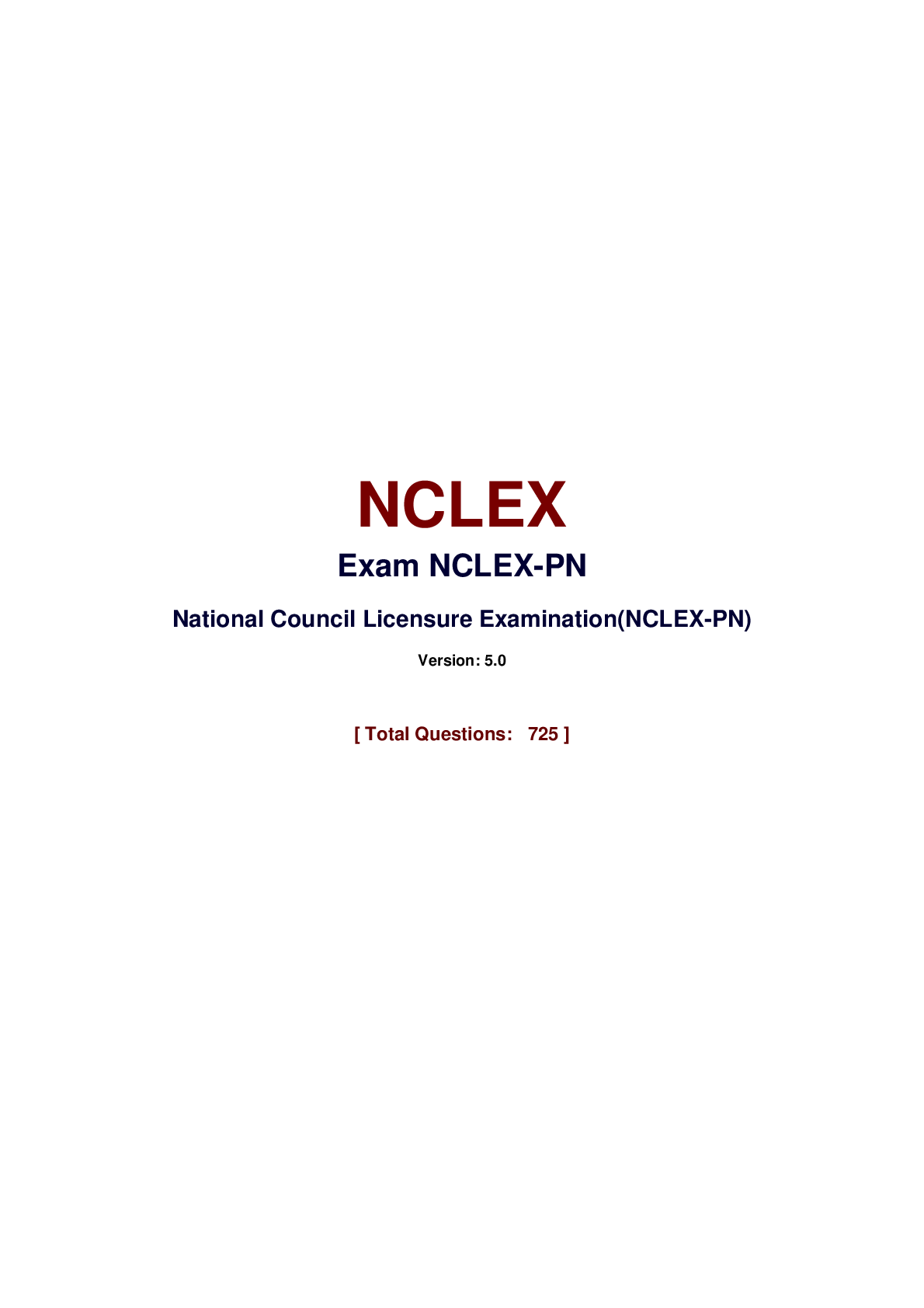

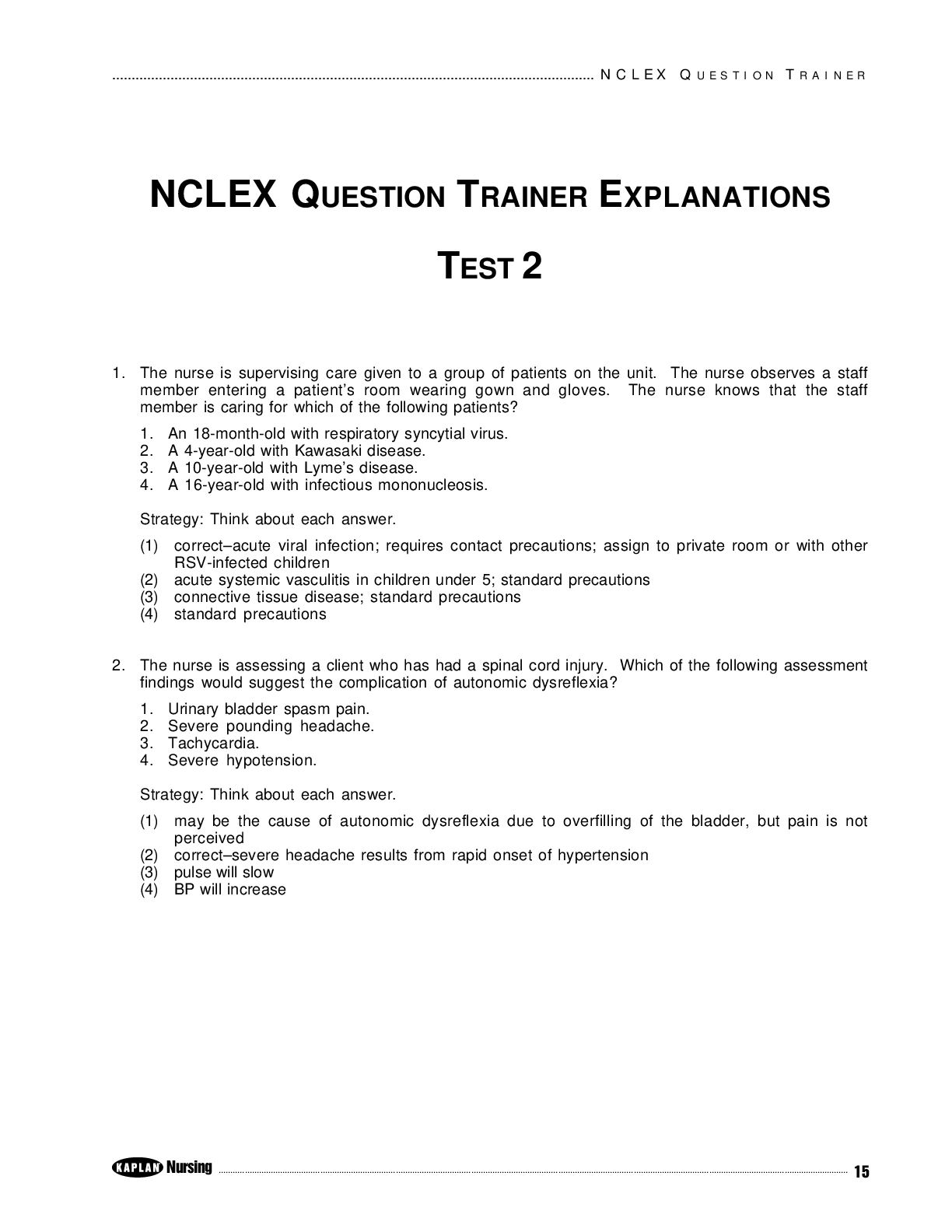
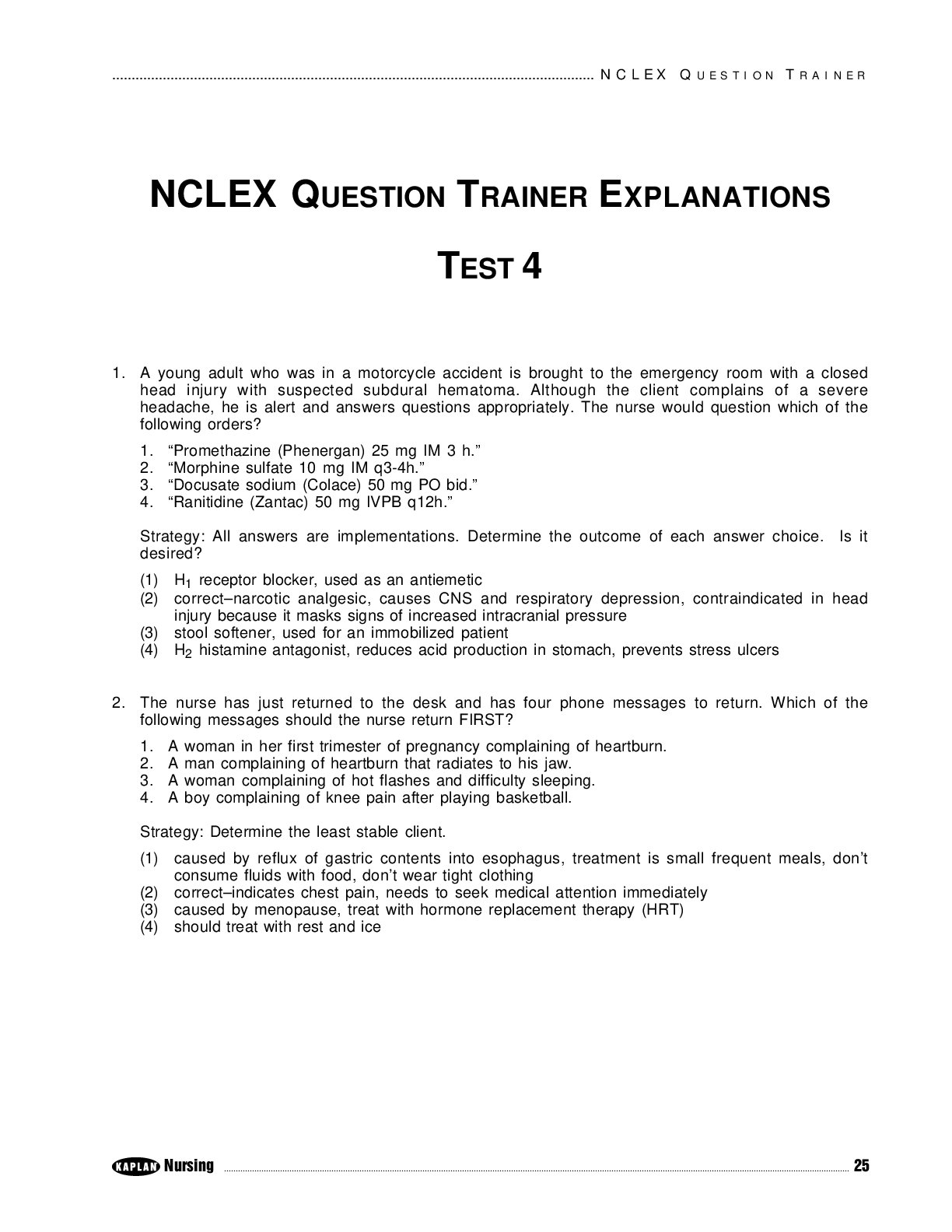
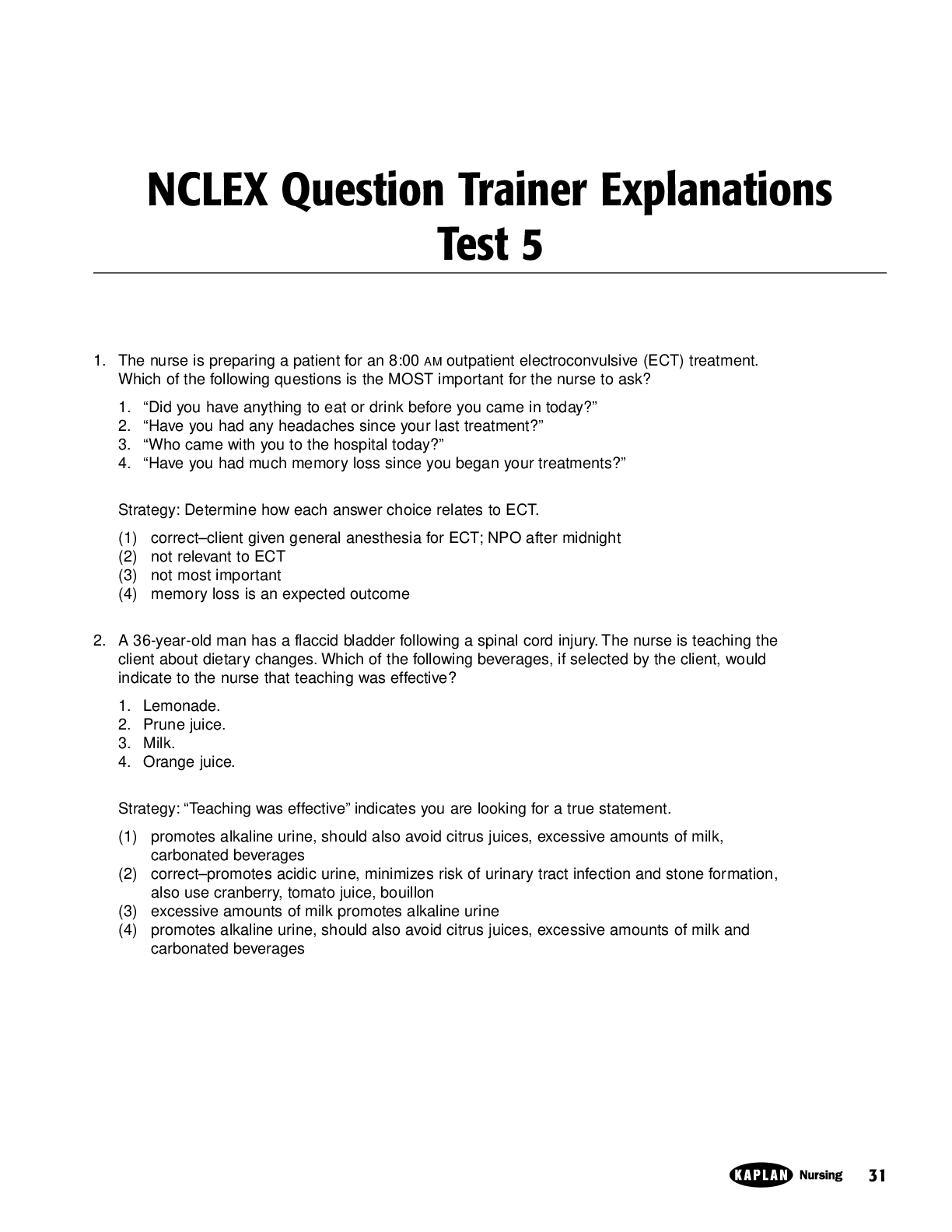
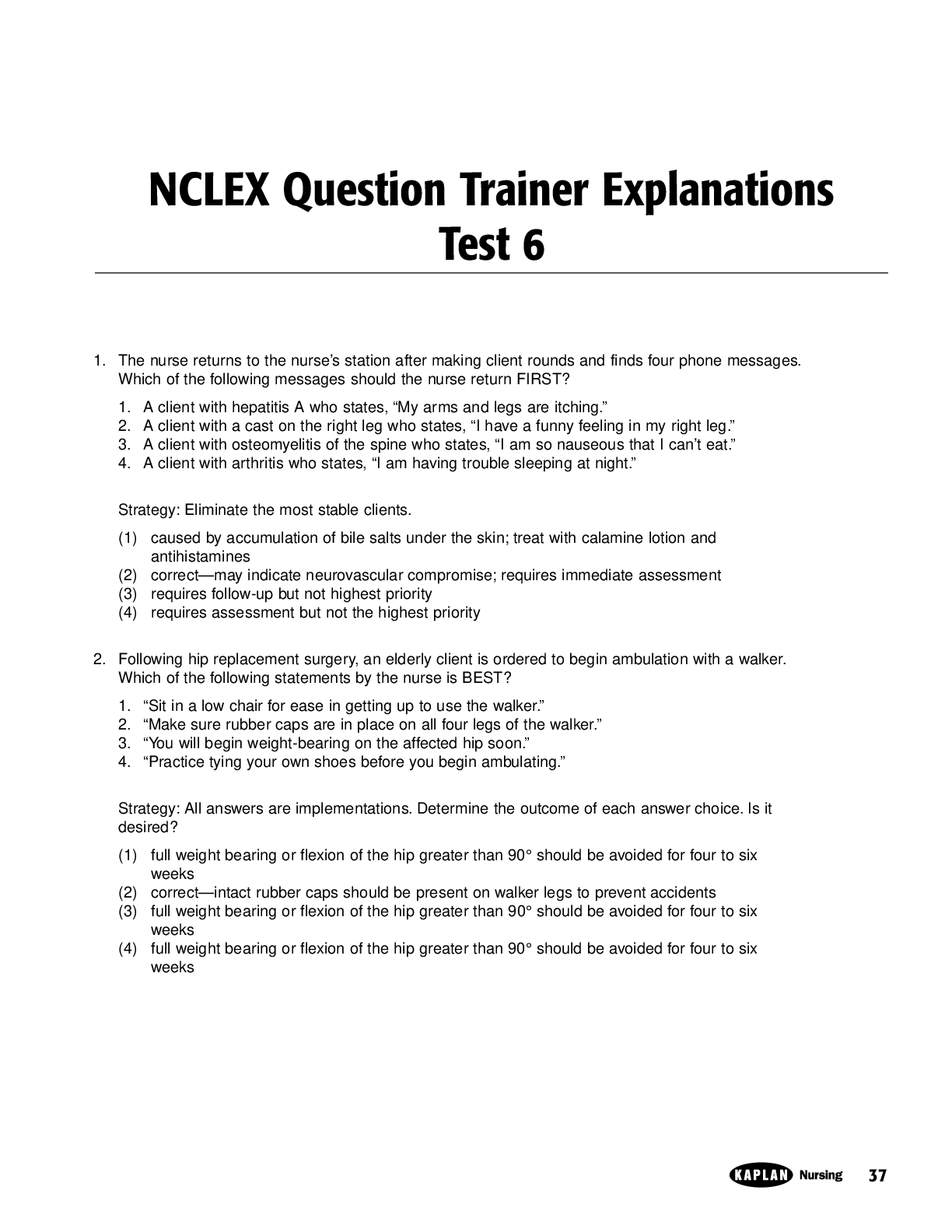
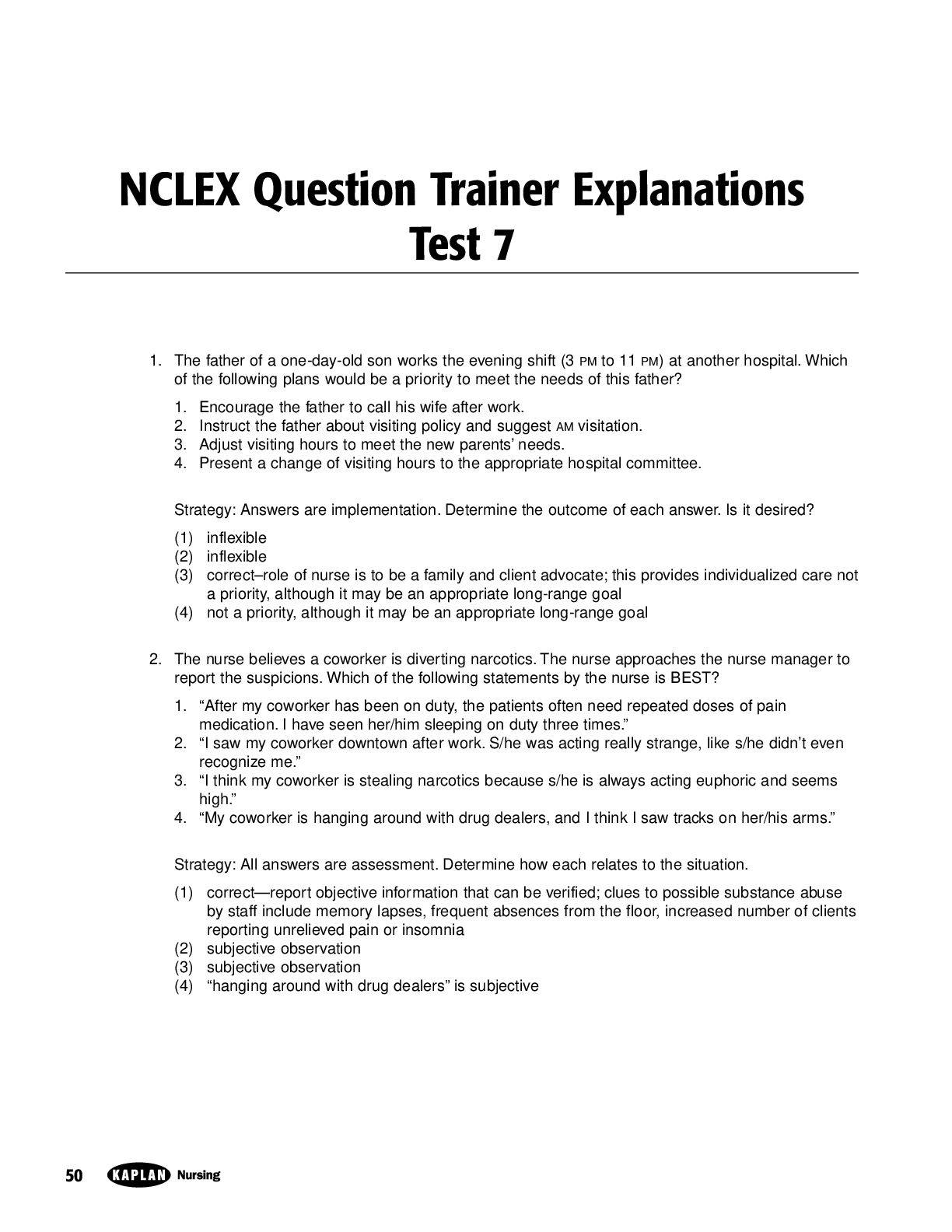
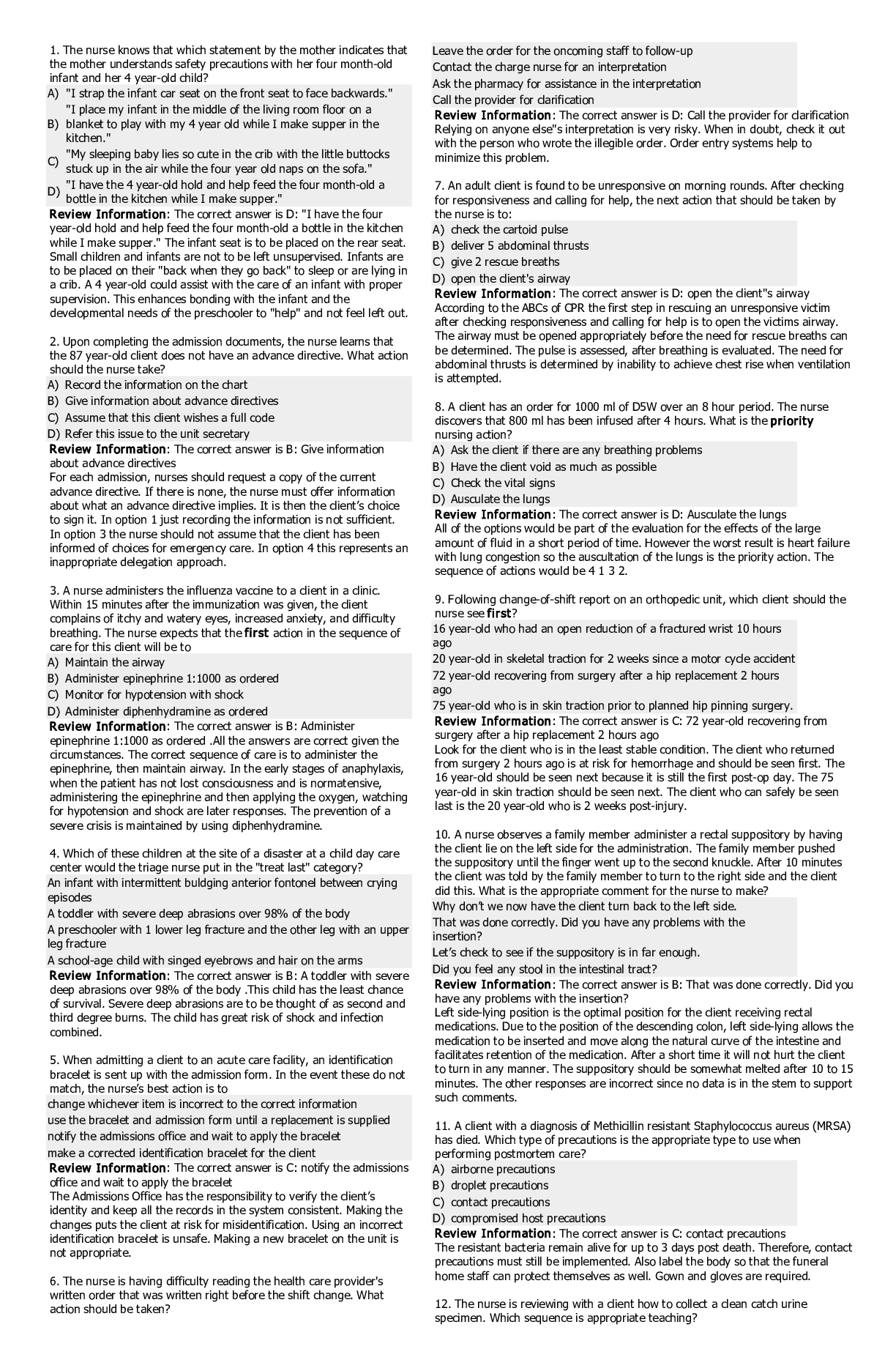
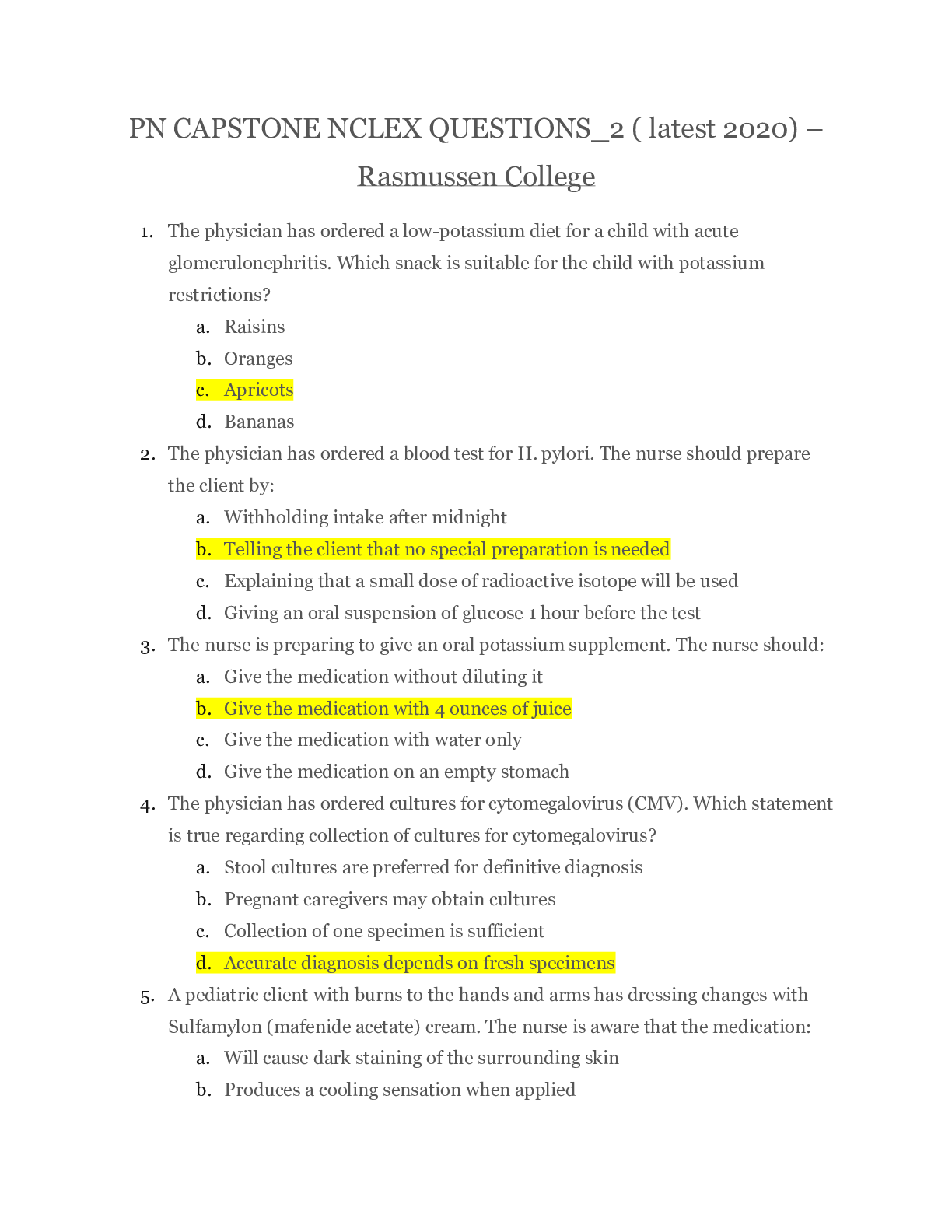

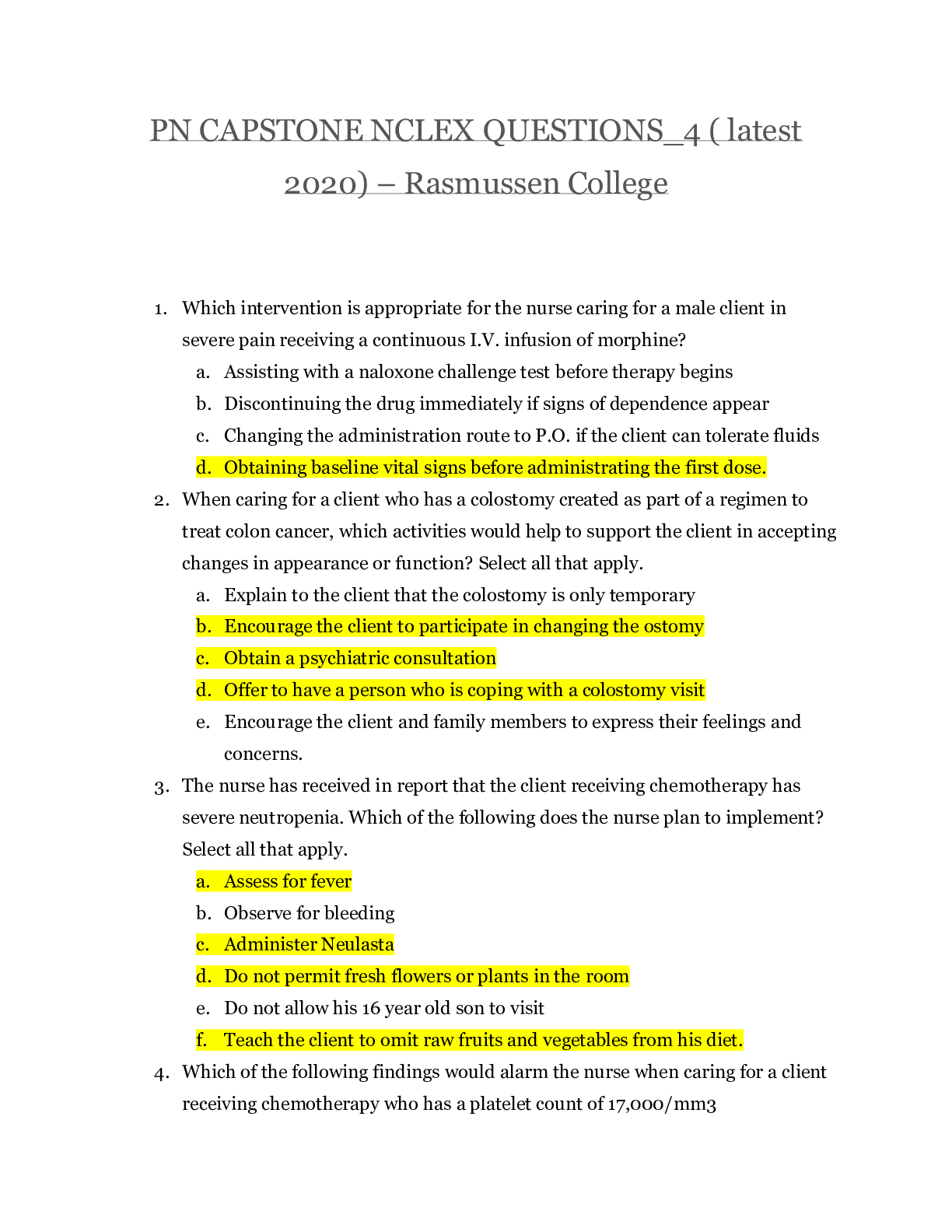


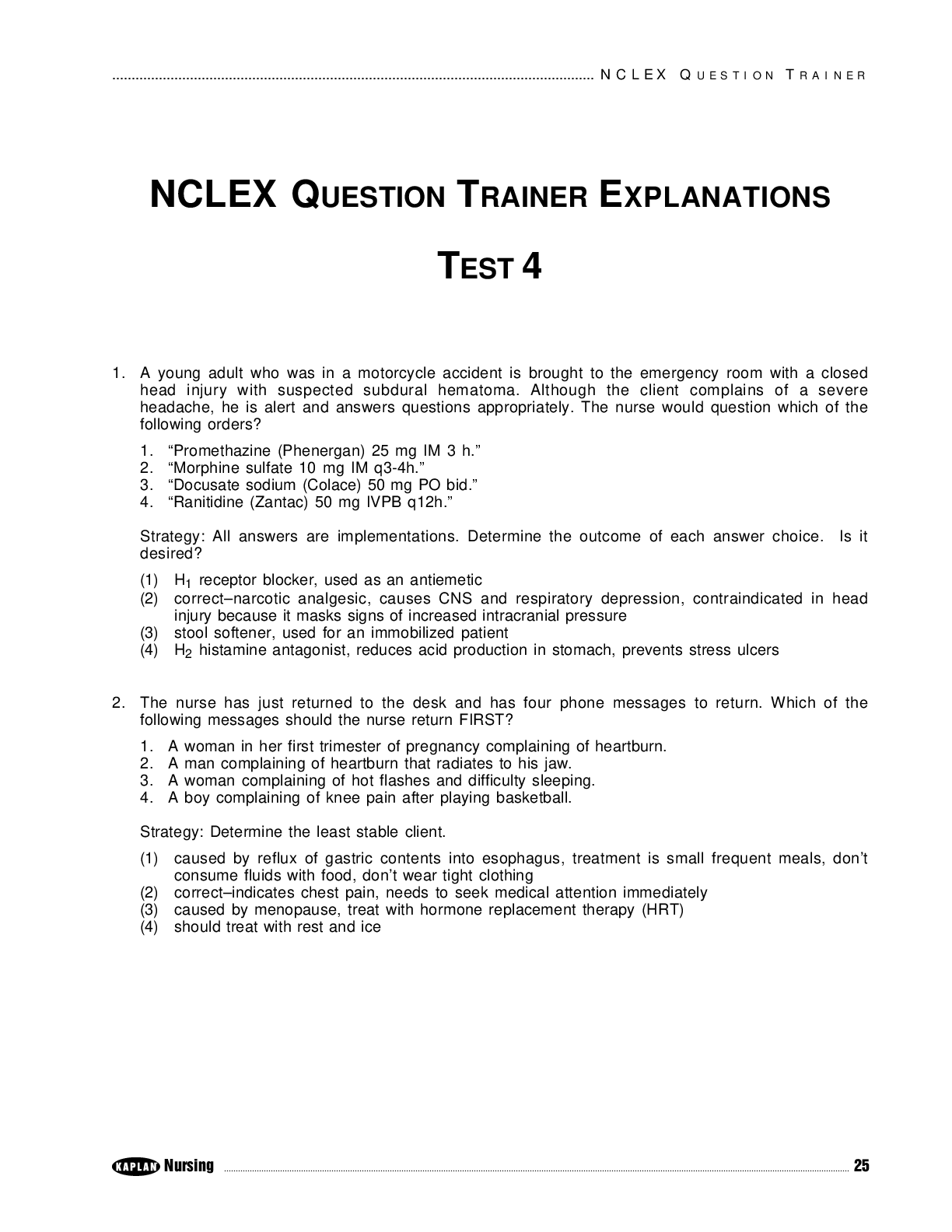
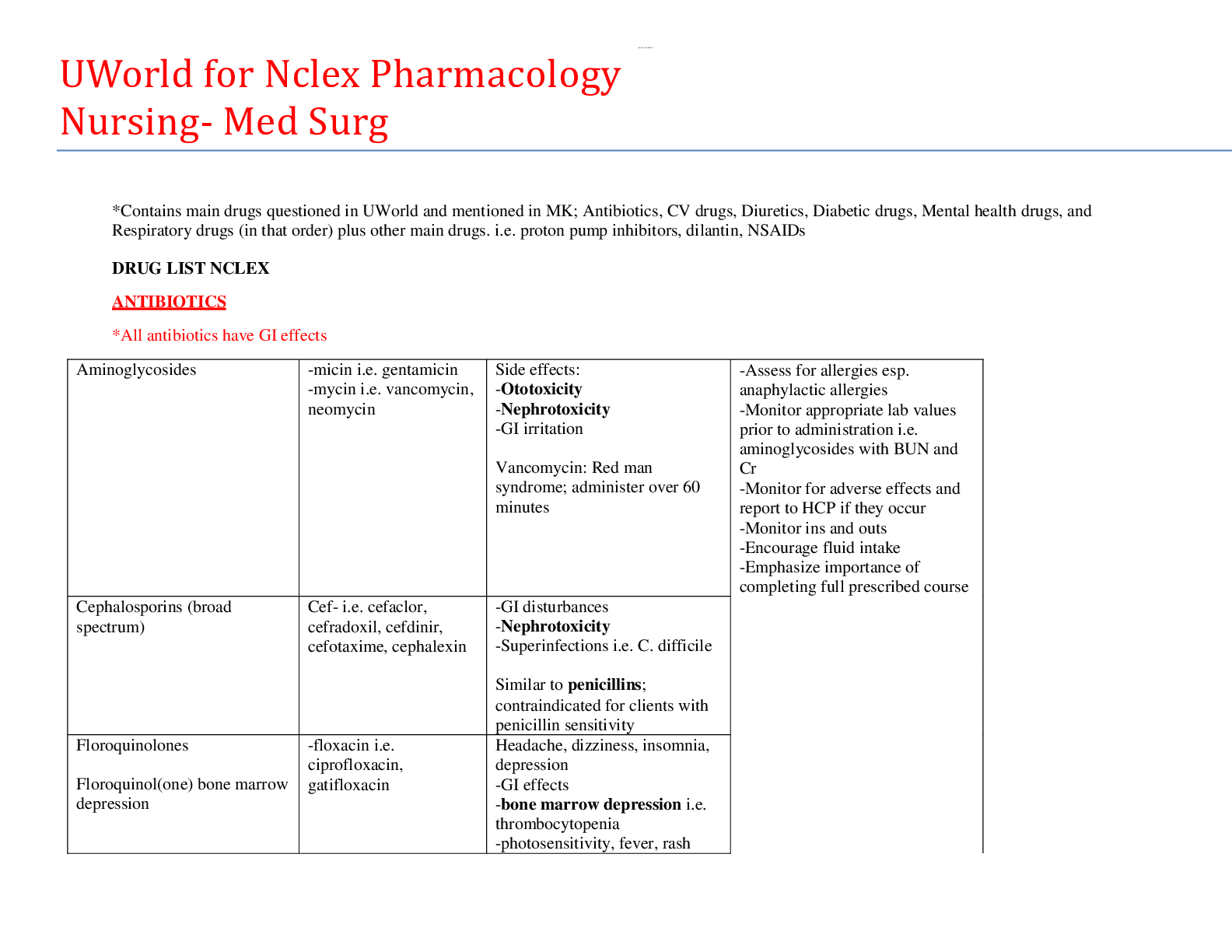

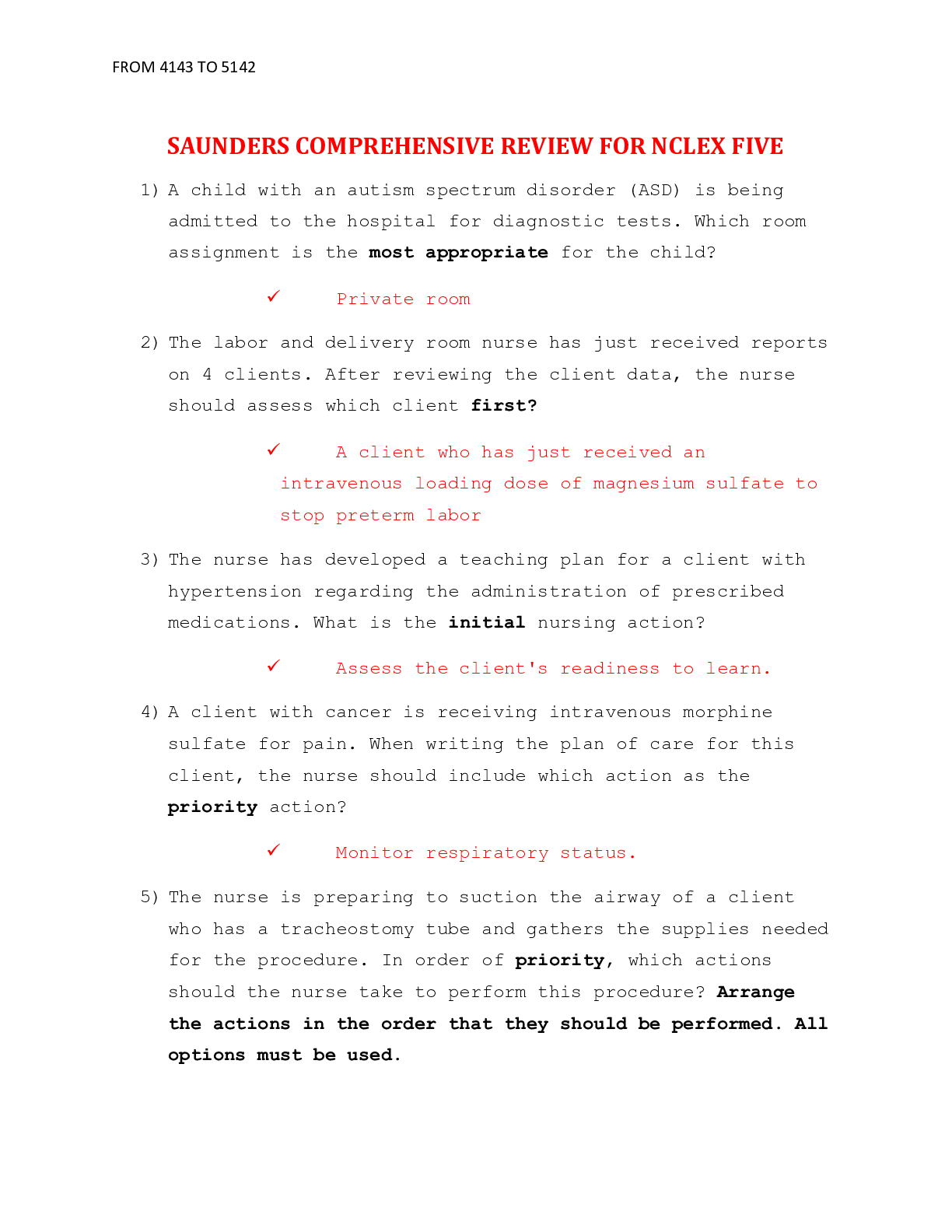
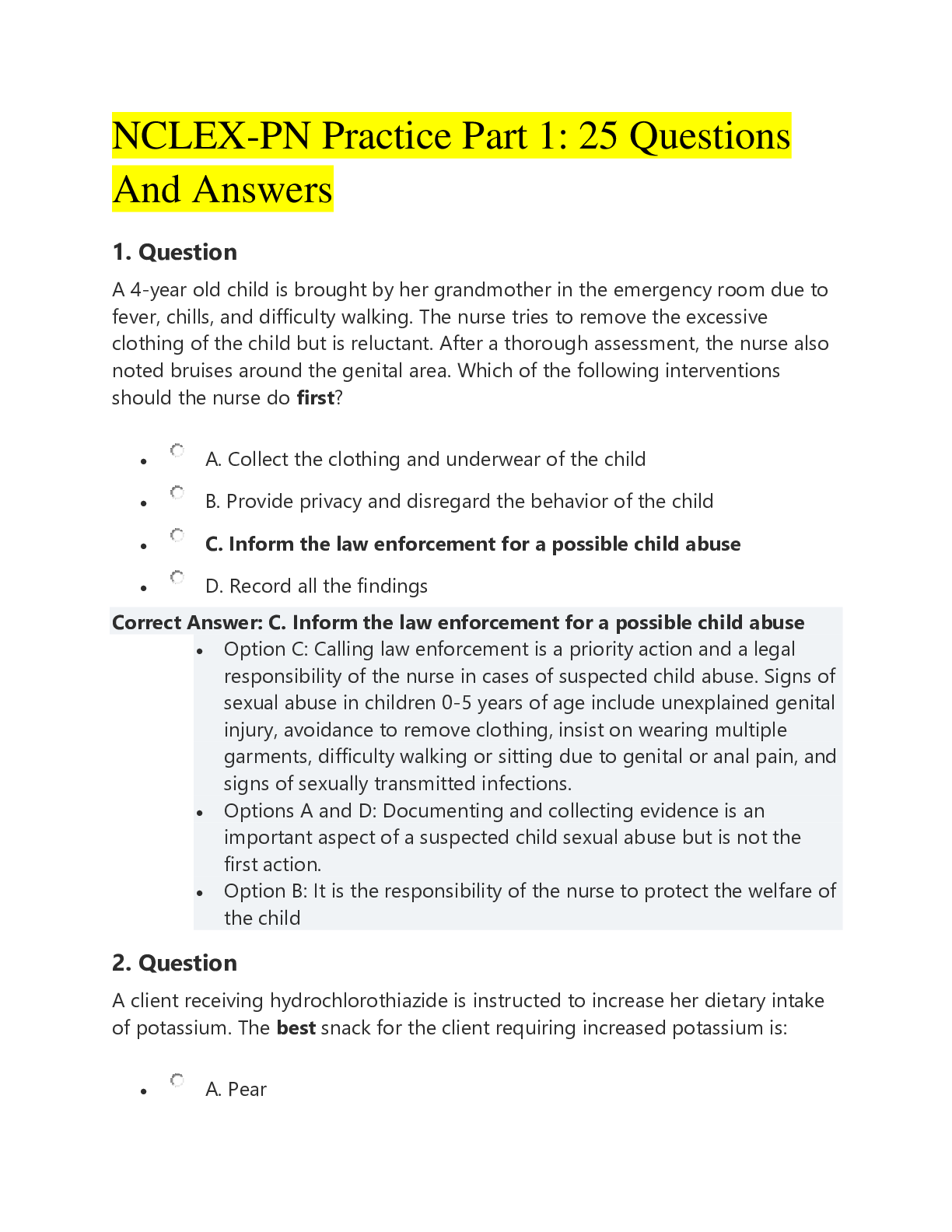
.png)
